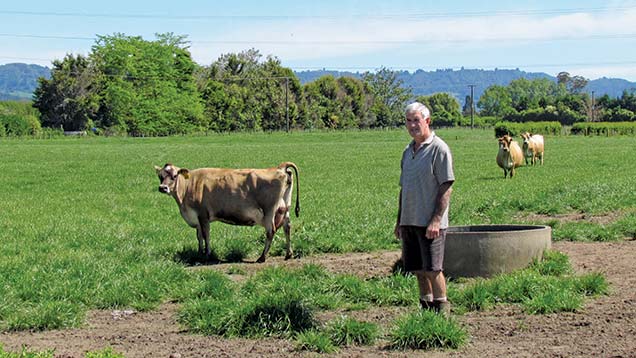On-off grazing and feed pad help save pastures

Bay of Plenty dairy farmers Bruce and Judy Woods had limited options to increase milk production, as their 142ha dairy farm was land locked.
And with a stocking rate of 3.3 cows a hectare, they did not want to reduce cow numbers from 460. However, an analysis of the strengths and weaknesses of their business soon identified that, with 1,400-1,500mm rainfall annually, poaching was a big problem.
“We have had up to 3,000mm of rain in some years. Pasture losses can be 50% and it takes 18 months for the paddocks to recover,” says Mr Woods.
See also: Low milk prices see New Zealand dairy farmers adopt UK approach
While he aims to keep pasture residuals at 1,500-1,600kg/ha DM, overgrazing was also causing problems. But with the addition of a feed pad and an on-off grazing system, he believes that 2-3t/ha of extra grass can be harvested.
“It’s nicer for the cows and the pasture isn’t harmed,” he says.
Farm fact
- Dreamfields Farm, Bay of Plenty, North Island, New Zealand
- 142ha
- 480 Jerseys
- 7.5ha of maize grown for silage on neighbouring block
- Feed 1-2kg a cow a day of barley/rapeseed meal and an equal amount of palm kernel fed depending on grass availability and quality; grass silage on hand from last season
“And pasture at $0.34/kg (17p/kg) DM isn’t a cheap feed if you take into account the value of your land at $50,000/ha (£25,073/ha) then add the 7% interest rate and a couple of thousand dollars a hectare for fertiliser.”
He looked at a range of different feed pad options, providing each cow with 8sq m of space on soft bedding and 700cm at the feed trough.
The building, completed in late 2012 close to their 20-aside double-up parlour, covers 4,200sq m with three separate bays and two feed passages. In total, the investment came to $1.2m (£600,000).
Feeding
About 30t of barley is mixed with rapeseed meal and fed when grass is going to seed. During the calving and breeding period, cows are fed 1-2kg barley and 1-2kg palm kernel both bought on contract, depending on grass availability and quality.
Last season, 130t of grass silage was bought in at $0.30/kg (15p/kg) DM and ensiled on farm, but no extra has been needed this season.
They grow 7.5ha of maize on a neighbouring block at an estimated cost of $0.17/kg (9p/kg) DM, but if the value of the land is included, it is nearer $0.34/kg (17p/kg) DM.
It is up to 10C cooler in the shed, so on summer days over 24C, the usual routine of putting the cows out at first light and bringing them back at 4pm is varied to let them spend afternoons inside.
The flooring is made up of layers of drainage material, clean pumice, wood pulp and sawdust, with the top layer worked up every day to incorporate dung. It is cleaned out regularly with a scraper, heaped up to compost and spread on maize paddocks instead of using fertiliser in the spring.
Organic fertiliser
Mr Woods is deputy chairman of his local council’s water advisory committee and recognises the value turning effluent into an environmentally friendly organic fertiliser.
“It will have a big impact on our fertiliser bill,” he says. “Four million New Zealanders are telling us how to farm so it’s best to be the dog at the front of the pack.”
Production increased by 30,000kg milk solids (MS) last season, or almost 100kg MS a cow to 205t MS a cow. They hope to hit 500kg MS a cow next season, with the future aim of running 600 cows at 4/ha.
“There’s a lot more production in the system,” says Mr Woods.
